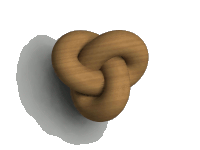 Beginnings
Beginnings
This page has a selection of my oldest raytracing experiments, some of
which probably date back to 1991. Computers were slow back then, so don't
go expecting any hi-res miracles! Many of them represent an attempt to try
something new, scene development stemming from modelling or texturing
features that I'd never used before. The images aren't in any particular
order (chronological or otherwise).
(Note: some of these images are blurry, for two reasons: firstly, I didn't
have a 24-bit display so all my output files had to be dithered into 8-bit
indexed images for viewing. Smoothing was an attempt to reverse the
dithering. Secondly, I didn't use anti-aliasing because it took too long.
Smoothing was an attempt to correct the jaggies.)
Some of the images are thumbnail links; click to see larger versions where
applicable!

|
Oranges
My first use of procedural texturing, and bump normals. The mirrors are
slightly washed-out because I didn't know to set ambient light to 0.
Rendered with an early version of RayShade. |

|
Studded orb
Rendered with an early version of RayShade. |
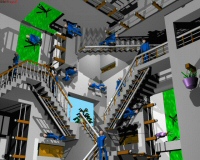
|
Relativity
M.C.Escher's Relativity lithograph is not an optical illusion. It is
conceptually confusing because it plays with the viewer's sense of
up and down, but it is a perfectly self-consistent 3D structure. There's no
easy way to model this kind of scene, so I did it the hard way - traced the
picture out of a book, and divided it up on my sketch into discrete boxes,
counting steps in x,y and z to work out all the dimensions. Rendered with
an early version of RayShade. |
 |
Columns and pool
Part of a school art project. Very simple geometry; it probably looks its
best at this resolution. Rendered with an early version of RayShade. |
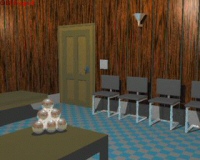 |
Waiting room
Based loosely on the panelled waiting room at the dental surgery I was
taken to as a child. I've given the mirrored surfaces a non-zero ambient
value again, tut tut. Rendered with an early version of RayShade. |
 |
Air car
It's a great shame that this image has suffered from such bad aliasing and
dithering jaggies, because it's all that I have left of a very interesting
set of permutations on this theme. This would have been one of my very
first POV-Ray scenes, playing with constructive solid geometry (CSG) and
image-mapping (if you can just make out the detail between the engine
pods). |
 |
Arched hallway |
 |
Pillar
A promising idea that I might take up again. I can still see what I was
trying to do in my mind's eye, surreal and spectacular. |
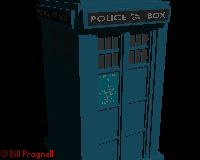 |
TARDIS
As a long-standing Doctor Who fan, this was inevitable really. |

|
Planet from orbit
This appears to be an extensive texturing exercise; a realistic
depiction of this theme still eludes me today. It used the halo
feature in POV-Ray 3.1 to simulate the atmosphere glow on the horizon, and
the starfield and cloud patterns turned out quite well too. |
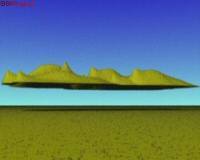
|
Hills in the sky
A genuine mistake while developing another image (see below), I evidently
found this sufficiently hilarious to be worth preserving for
posterity. |

|
Clock
I do believe this was my first use of CSG. Pretty trivial apart from
that. |
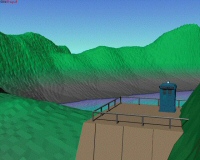
|
TARDIS with landscape
Experiments with heighfields. |

|
Pit
Spotlights and general CSG practice. Although the area around the centre of
the image looks quite good, the rest of it is hopelessly busy. |

|
Spacecraft
The starfield is a little munged; I couldn't see the problem until it had
finished rendering the full-size version (no preview). The rest looks quite
good, I think. This was an exercise in imagemaps, but I tend to stay away
from them these days except for pictures on walls, writing etc. Please note
the use of a pink sub-light to simulate the planet's glow (no radiosity in
those days!). |

|
Pumping station
This was fun. No procedural texturing at all (apart from the bump map on
the desert floor), this was an attempt at detail via physical objects. |

|
Table
This was all about wooden objects, and the possibility of realistic glass.
I don't know why I thought that making both elements of the scene so small
was a good idea, though. Additionally, this appears to have suffered
greatly from insufficient antialiasing. Not a complete waste of time,
though. |
 Beginnings
Beginnings


















